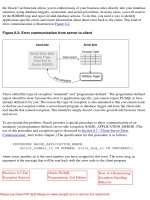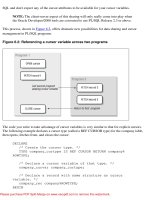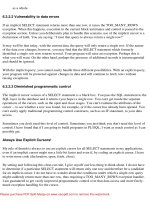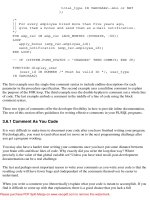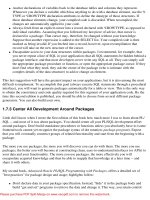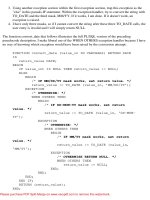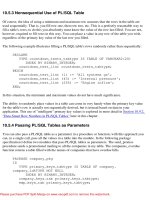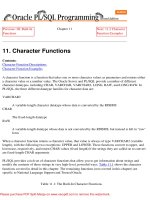OReilly oracle PLSQL language pocket reference may 1999 ISBN 1565924576 pdf
Bạn đang xem bản rút gọn của tài liệu. Xem và tải ngay bản đầy đủ của tài liệu tại đây (239.72 KB, 79 trang )
[Chapter 1] Oracle PL/SQL Language Pocket Reference
[Chapter 1] Oracle PL/SQL Language Pocket Reference
Table of Contents
1. Oracle PL/SQL Language Pocket Reference...............................................................................................2
1.1 Introduction........................................................................................................................................2
...............................................................................................................................................................................3
1.2 Acknowledgments..............................................................................................................................3
...............................................................................................................................................................................4
1.3 Conventions.......................................................................................................................................4
...............................................................................................................................................................................5
1.4 PL/SQL Language Fundamentals......................................................................................................5
1.4.1 The PL/SQL Character Set................................................................................................5
.............................................................................................................................................................................10
1.5 Variables and Program Data............................................................................................................10
1.5.1 Scalar Datatypes..............................................................................................................10
1.5.2 NLS Character Datatypes................................................................................................13
1.5.3 LOB Datatypes................................................................................................................13
1.5.4 NULLs in PL/SQL...........................................................................................................13
1.5.5 Declaring Variables.........................................................................................................14
1.5.6 Anchored Declarations....................................................................................................14
1.5.7 Programmer−Defined Subtypes.......................................................................................15
.............................................................................................................................................................................17
1.6 Conditional and Sequential Control.................................................................................................17
1.6.1 Conditional Control Statements.......................................................................................17
1.6.2 Sequential Control Statements.........................................................................................18
.............................................................................................................................................................................19
1.7 Loops...............................................................................................................................................19
1.7.1 The Simple Loop.............................................................................................................19
1.7.2 The Numeric FOR Loop..................................................................................................19
1.7.3 The Cursor FOR Loop.....................................................................................................20
1.7.4 The WHILE Loop............................................................................................................20
1.7.5 The REPEAT UNTIL Loop Emulation...........................................................................20
1.7.6 The EXIT Statement........................................................................................................21
1.7.7 Loop Labels.....................................................................................................................21
.............................................................................................................................................................................22
1.8 Database Interaction and Cursors....................................................................................................22
1.8.1 Transaction Management.................................................................................................22
1.8.2 Native Dynamic SQL (Oracle8i).....................................................................................23
1.8.3 Autonomous Transactions (Oracle8i)..............................................................................24
.............................................................................................................................................................................26
1.9 Cursors in PL/SQL...........................................................................................................................26
1.9.1 Explicit Cursors...............................................................................................................26
1.9.2 Implicit Cursors...............................................................................................................28
1.9.3 Cursor Variables..............................................................................................................30
.............................................................................................................................................................................32
1.10 Exception Handling.......................................................................................................................32
1.10.1 Declaring Exceptions.....................................................................................................32
1.10.2 Raising Exceptions........................................................................................................33
1.10.3 Scope..............................................................................................................................34
1.10.4 Propagation....................................................................................................................34
.............................................................................................................................................................................36
1.11 Records in PL/SQL........................................................................................................................36
1.11.1 Declaring Records..........................................................................................................36
1.11.2 Referencing Fields of Records.......................................................................................37
1.11.3 Record Assignment........................................................................................................37
i
[Chapter 1] Oracle PL/SQL Language Pocket Reference
Table of Contents
1.11.4 Nested Records..............................................................................................................38
.............................................................................................................................................................................39
1.12 Named Program Units....................................................................................................................39
1.12.1 Procedures......................................................................................................................39
1.12.2 Functions........................................................................................................................39
1.12.3 Parameters......................................................................................................................41
.............................................................................................................................................................................46
1.13 Triggers..........................................................................................................................................46
1.13.1 Creating Triggers...........................................................................................................46
1.13.2 Trigger Predicates..........................................................................................................47
1.13.3 DML Events...................................................................................................................48
1.13.4 DDL Events (Oracle8i)..................................................................................................48
1.13.5 Database Events (Oracle8i)...........................................................................................48
.............................................................................................................................................................................49
1.14 Packages.........................................................................................................................................49
1.14.1 Overview of Package Structure.....................................................................................49
1.14.2 Referencing Package Elements......................................................................................50
1.14.3 Package Data..................................................................................................................51
1.14.4 Package Initialization.....................................................................................................51
.............................................................................................................................................................................53
1.15 Calling PL/SQL Functions in SQL................................................................................................53
1.15.1 Syntax for Calling Stored Functions in SQL.................................................................53
1.15.2 Requirements and Restrictions on Stored Functions in SQL........................................53
1.15.3 Calling Packaged Functions in SQL..............................................................................54
.............................................................................................................................................................................56
1.16 Oracle8 Objects..............................................................................................................................56
1.16.1 Object Types..................................................................................................................56
1.16.2 Methods.........................................................................................................................57
1.16.3 Manipulating Objects in PL/SQL and SQL...................................................................58
1.16.4 Changing Object Types.................................................................................................60
.............................................................................................................................................................................62
1.17 Collections.....................................................................................................................................62
1.17.1 Syntax for Declaring Collection Datatypes...................................................................63
1.17.2 Initializing Collections...................................................................................................63
1.17.3 Adding and Removing Elements...................................................................................64
1.17.4 Collection Pseudo−Functions........................................................................................65
1.17.5 Collection Methods........................................................................................................65
1.17.6 Privileges.......................................................................................................................67
1.17.7 Bulk Binds (Oracle8i)....................................................................................................67
.............................................................................................................................................................................69
1.18 External Procedures.......................................................................................................................69
1.18.1 Creating an External Procedure.....................................................................................69
1.18.2 Parameters......................................................................................................................71
.............................................................................................................................................................................73
1.19 Java Language Integration.............................................................................................................73
1.19.1 Example.........................................................................................................................73
1.19.2 Publishing Java to PL/SQL............................................................................................74
1.19.3 Data Dictionary..............................................................................................................75
.............................................................................................................................................................................76
Table of Contents...................................................................................................................................76
ii
Chapter 1
1
1. Oracle PL/SQL Language Pocket Reference
Contents:
Introduction
Acknowledgments
Conventions
PL/SQL Language Fundamentals
Variables and Program Data
Conditional and Sequential Control
Loops
Database Interaction and Cursors
Cursors in PL/SQL
Exception Handling
Records in PL/SQL
Named Program Units
Triggers
Packages
Calling PL/SQL Functions in SQL
Oracle8 Objects
Collections
External Procedures
Java Language Integration
1.1 Introduction
The Oracle PL/SQL Language Pocket Reference is a quick reference guide to the PL/SQL programming
language, which provides procedural extensions to the SQL relational database language and a range of
Oracle development tools.
Where a package, program, or function is supported only for a particular version of Oracle (e.g., Oracle8i), we
indicate this in the text.
The purpose of this pocket reference is to help PL/SQL users find the syntax of specific language elements. It
is not a self−contained user guide; basic knowledge of the PL/SQL programming language is required. For
more information, see the following books:
Oracle PL/SQL Programming, 2nd Edition, by Steven Feuerstein with Bill Pribyl (O'Reilly & Associates,
1997).
Oracle Built−in Packages, by Steven Feuerstein, Charles Dye, and John Beresniewicz (O'Reilly &
Associates, 1998).
Oracle PL/SQL Built−ins Pocket Reference, by Steven Feuerstein, John Beresniewicz, and Chip Dawes
(O'Reilly & Associates, 1998).
1.2 Acknowledgments
Copyright (c) 2000 O'Reilly & Associates. All rights reserved.
1. Oracle PL/SQL Language Pocket Reference
2
Chapter 1
Oracle PL/SQL Language
Pocket Reference
1.2 Acknowledgments
We would like to thank our reviewers: Eric J. Givler, Department of Environmental Protection, Harrisburg,
Pennsylvania; and Stephen Nelson, HK Systems, New Berlin, Wisconsin.
1.1 Introduction
1.3 Conventions
Copyright (c) 2000 O'Reilly & Associates. All rights reserved.
3
Chapter 1
Oracle PL/SQL Language
Pocket Reference
1.3 Conventions
UPPERCASE indicates PL/SQL keywords.
lowercase indicates user−defined items such as parameters.
Italic indicates file names and parameters within text.
Constant width is used for code examples.
[] enclose optional items in syntax descriptions.
{ } enclose a list of items in syntax descriptions; you must choose one item from the list.
| separates bracketed list items in syntax descriptions.
1.2 Acknowledgments
1.4 PL/SQL Language
Fundamentals
Copyright (c) 2000 O'Reilly & Associates. All rights reserved.
4
Chapter 1
Oracle PL/SQL Language
Pocket Reference
1.4 PL/SQL Language Fundamentals
1.4.1 The PL/SQL Character Set
The PL/SQL language is constructed from letters, digits, symbols, and whitespace, as defined in the following
table.
Type
Characters
Letters
A−Z, a−z
Digits
0−9
Symbols
~!@#$%&*()_−+=|[ ]{ }:;"'< >?/
Whitespace space, tab, carriage return
Characters are grouped together into the four lexical units: identifiers, literals, delimiters, and comments.
1.4.1.1 Identifiers
Identifiers are names for PL/SQL objects such as constants, variables, exceptions, procedures, cursors, and
reserved words. Identifiers:
•
Can be up to 30 characters in length
•
Cannot include whitespace (space, tab, carriage return)
•
Must start with a letter
•
Can include a dollar sign ($), an underscore ( _ ), and a pound sign (#)
•
Are not case−sensitive
If you enclose an identifier within double quotes, then all but the first of these rules are ignored. For example,
the following declaration is valid:
DECLARE
"1 ^abc" VARCHAR2(100);
BEGIN
IF "1 ^abc" IS NULL THEN ...
END;
5
[Chapter 1] Oracle PL/SQL Language Pocket Reference
1.4.1.2 Literals
Literals are specific values not represented by identifiers. For example, TRUE, 3.14159, 6.63E−34, `Moby
Dick', and NULL are all literals of type Boolean, number, or string. There are no date or complex datatype
literals as they are internal representations. Unlike the rest of PL/SQL, literals are case−sensitive. To embed
single quotes within a string literal, place two single quotes next to each other. See the following table for
examples.
Literal
Actual Value
'That''s Entertainment!' That's Entertainment!
'"The Raven"'
"The Raven"
'TZ="CDT6CST"'
TZ='CDT6CST'
''''
'
'''hello world'''
'hello world'
''''''
1.4.1.3 Delimiters
''
Delimiters are symbols with special meaning, such as := (assignment operator), || (concatenation operator),
and ; (statement delimiter). The following table lists delimiters.
Delimiter
Description
;
Statement terminator
+
Addition operator
−
Subtraction operator
*
Multiplication operator
/
Division operator
**
Exponentiation operator
||
Concatenation operator
:=
Assignment operator
=
Equality operator
<> and != Inequality operators
^= and ~= Inequality operators
<
"Less than" operator
<=
"Less than or equal to" operator
>
"Greater than" operator
>=
"Greater than or equal to" operator
( and )
Expression or list delimiters
<< and >> Label delimiters
,
Item separator
`
Literal delimiter
"
Quoted literal delimiter
:
Host variable indicator
1.4.1 The PL/SQL Character Set
6
[Chapter 1] Oracle PL/SQL Language Pocket Reference
%
Attribute indicator
.
Component indicator (as in record.field or package.element)
@
Remote database indicator (database link)
=>
Association operator (named notation)
..
Range operator (used in the FOR loop)
−−
Single−line comment indicator
/* and */ Multiline comment delimiters
1.4.1.4 Comments
Comments are sections of the code that exist to aid readability. The compiler ignores them.
A single−line comment begins with a double hyphen () and ends with a new line. The compiler ignores all
characters between the and the new line.
Multiline comments begin with slash asterisk (/*) and end with asterisk slash (*/). The /* */ comment
delimiters can also be used on a single−line comment. The following block demonstrates both kinds of
comments:
DECLARE
−− Two dashes comment out only the physical line.
/* Everything is a comment until the compiler
encounters the following symbol */
You cannot embed multiline comments within a multiline comment, so care needs to be exercised during
development if you comment out portions of code that include comments. The following code demonstrates:
DECLARE
/* Everything is a comment until the compiler
/* This comment inside another WON'T work!*/
encounters the following symbol. */
/* Everything is a comment until the compiler
−− This comment inside another WILL work!
encounters the following symbol. */
1.4.1.5 Pragmas
The PRAGMA keyword is used to give instructions to the compiler. There are four types of pragmas in
PL/SQL:
EXCEPTION_INIT
Tells the compiler to associate the specified error number with an identifier that has been declared an
EXCEPTION in your current program or an accessible package. See the Section 1.10, "Exception
Handling " section for more information on this pragma.
RESTRICT_REFERENCES
Tells the compiler the purity level of a packaged program. The purity level is the degree to which a
program does not read/write database tables and/or package variables. See the Section 1.15, "Calling
PL/SQL Functions in SQL" section for more information on this pragma.
SERIALLY_REUSABLE
Tells the runtime engine that package data should not persist between references. This is used to
reduce per−user memory requirements when the package data is only needed for the duration of the
call and not for the duration of the session. See the Section 1.14, "Packages" section for more
1.4.1 The PL/SQL Character Set
7
[Chapter 1] Oracle PL/SQL Language Pocket Reference
information on this pragma.
AUTONOMOUS_TRANSACTION (Oracle8i )
Tells the compiler that the function, procedure, top−level anonymous PL/SQL block, object method,
or database trigger executes in its own transaction space. See the Section 1.8, "Database Interaction
and Cursors " section for more information on this pragma.
1.4.1.6 Statements
A PL/SQL program is composed of one or more logical statements. A statement is terminated by a semicolon
delimiter. The physical end−of−line marker in a PL/SQL program is ignored by the compiler, except to
terminate a single−line comment (initiated by the symbol).
1.4.1.7 Block structure
Each PL/SQL program is a block consisting of a standard set of elements, identified by keywords (see Figure
1.1). The block determines the scope of declared elements, and how exceptions are handled and propagated. A
block can be anonymous or named. Named blocks include functions, procedures, packages, and triggers. Here
is an example of an anonymous block:
DECLARE
whoops NUMBER DEFAULT 99;
BEGIN
−− Display a two−digit year number.
DBMS_OUTPUT.PUT_LINE ('What century?
END;
' || whoops);
Here is a named block that performs the same action:
CREATE OR REPLACE PROCEDURE show_the_problem
IS
whoops NUMBER DEFAULT 99;
BEGIN
−− Display a two−digit year number.
DBMS_OUTPUT.PUT_LINE ('What century? ' || whoops);
END show_the_problem;
Figure 1.1: The PL/SQL block structure
The following table describes the sections of a PL/SQL block:
Section
Description
Header
1.4.1 The PL/SQL Character Set
8
[Chapter 1] Oracle PL/SQL Language Pocket Reference
Required for named blocks. Specifies the way the program is called by outer PL/SQL blocks.
Anonymous blocks do not have a header. They start with the DECLARE keyword if there is a
declaration section, or with the BEGIN keyword if there are no declarations.
Declaration Optional; declares variables, cursors, TYPEs, and local programs that are used in the block's
execution and exception sections.
Execution
Optional in package and type specifications; contains statements that are executed when the
block is run.
Exception
Optional; describes error handling behavior for exceptions raised in the executable section.
1.3 Conventions
1.5 Variables and Program
Data
Copyright (c) 2000 O'Reilly & Associates. All rights reserved.
1.4.1 The PL/SQL Character Set
9
Chapter 1
Oracle PL/SQL Language
Pocket Reference
1.5 Variables and Program Data
PL/SQL programs are normally used to manipulate database information. You commonly do this by declaring
variables and data structures in your programs, and then working with that PL/SQL−specific data.
A variable is a named instantiation of a data structure declared in a PL/SQL block (either locally or in a
package). Unless you declare a variable as a CONSTANT, its value can be changed at any time in your
program.
The following table describes several types of program data.
Type
Description
Scalar
Variables made up of a single value, such as a number, date, or Boolean.
Composite Variables made up of multiple values, such as a record or collection.
Reference Pointers to values.
LOB
Variables containing Large OBject (LOB) locators.
1.5.1 Scalar Datatypes
Scalar datatypes divide into four families: number, character, date−time, and Boolean.
1.5.1.1 Numeric datatypes
Numeric datatypes are further divided into decimal, binary integer, and PLS_INTEGER storage types.
Decimal numeric datatypes store fixed and floating−point numbers of just about any size. They include
NUMBER, DEC, DECIMAL, NUMERIC, FLOAT, REAL, and DOUBLE PRECISION. The maximum
precision of a variable with type NUMBER is 38 digits, which yields a range of values from 1.0E−129
through 9.999E125. This range of numbers would include the mass of an electron over the mass of the
universe or the size of the universe in angstroms.
Variables of type NUMBER can be declared with precision and scale, as follows:
NUMBER(precision, scale)
Precision is the number of digits, and scale denotes the number of digits to the right (positive scale) or left
(negative scale) of the decimal point at which rounding occurs. Legal values for the scale range from −84 to
127. The following table shows examples of precision and scale.
Declaration
Assigned Value Stored Value
NUMBER
6.02
6.02
NUMBER(4)
8675
8675
10
[Chapter 1] Oracle PL/SQL Language Pocket Reference
NUMBER(4)
8675309
Error
NUMBER(12,5)
3.14159265
3.14159
NUMBER(12,−5) 8675309
8700000
Binary integer numeric datatypes store whole numbers. They include BINARY_INTEGER, INTEGER, INT,
SMALLINT, NATURAL, NATURALN, POSITIVE, POSITIVEN, and SIGNTYPE. Binary integer datatypes
store signed integers in the range of −231 + 1 to 231 − 1. The subtypes include NATURAL (0 through 231) and
POSITIVE (1 through 231) together with the NOT NULL variations NATURALN and POSITIVEN.
SIGNTYPE is restricted to three values (−1, 0, 1).
PLS_INTEGER datatypes have the same range as the BINARY_INTEGER datatype, but use machine
arithmetic instead of library arithmetic, so are slightly faster for computation−heavy processing.
The following table lists the PL/SQL numeric datatypes with ANSI and IBM compatibility.
PL/SQL Datatype
Compatibility Oracle RDNMS Datatype
DEC(prec,scale)
ANSI
NUMBER(prec,scale)
DECIMAL(prec,scale) IBM
NUMBER(prec,scale)
DOUBLE PRECISION ANSI
NUMBER
FLOAT(binary)
ANSI, IBM
NUMBER
INT
ANSI
NUMBER(38)
INTEGER
ANSI, IBM
NUMBER(38)
NUMERIC(prec,scale) ANSI
NUMBER(prec,scale)
REAL
ANSI
NUMBER
SMALLINT
In the preceding table:
ANSI, IBM
NUMBER(38)
•
prec is the precision for the subtype.
•
scale is the scale of the subtype.
•
binary is the binary precision of the subtype.
1.5.1.2 Character datatypes
Character datatypes store alphanumeric text and are manipulated by character functions. As with the numeric
family, there are several subtypes in the character family, shown in the following table.
Family
Description
CHAR
Fixed−length alphanumeric strings. Valid sizes are 1 to 32767 bytes (which is larger
than the Oracle7 limit of 2000 and the Oracle8 limit of 4000).
VARCHAR2
Variable−length alphanumeric strings. Valid sizes are 1 to 32767 bytes (which is larger
than the Oracle7 limit of 2000 and the Oracle8 limit of 4000).
LONG
Variable−length alphanumeric strings. Valid sizes are 1 to 32760 bytes. LONG is
included primarily for backward compatibility since longer strings can now be stored in
1.5.1 Scalar Datatypes
11
[Chapter 1] Oracle PL/SQL Language Pocket Reference
VARCHAR2 variables.
RAW
Variable−length binary strings. Valid sizes are 1 to 32767 bytes (which is larger than
the Oracle7 and Oracle8 limit of 2000). RAW data do not undergo character set
conversion when selected from a remote database.
LONG RAW
Variable−length binary strings. Valid sizes are 1 to 32760 bytes. LONG RAW is
included primarily for backward compatibility since longer strings can now be stored in
RAW variables.
ROWID
Fixed−length binary data. Every row in a database has a physical address or ROWID.
An Oracle7 (restricted) ROWID has 3 parts in base 16 (hex):
BBBBBBBB.RRRR.FFFF.
An Oracle8 (extended) ROWID has 4 parts in base 64:
OOOOOOFFFBBBBBBRRR.
where:
OOOOOO is the object number.
FFFF (FFF) is the absolute (Oracle 7) or relative (Oracle8) file number.
BBBBBBBB (BBBBBB) is the block number within the file.
RRRR (RRR) is the row number within the block.
UROWID
(Oracle8i)
Universal ROWID. Variable−length hexadecimal string depicting a logical ROWID.
Valid sizes are up to 4000 bytes. Used to store the addresses of rows in index organized
tables or IBM DB2 tables via Gateway.
1.5.1.3 Date−time datatypes
DATE values are fixed−length, date−plus−time values. The DATE datatype can store dates from January 1,
4712 B.C. to December 31, 4712 A.D. Each DATE includes the century, year, month, day, hour, minute, and
second. Sub−second granularity is not supported via the DATE datatype. The time portion of a DATE
defaults to midnight (12:00:00 AM) if it is not included explicitly. The internal calendar follows the Papal
standard of Julian to Gregorian conversion in 1582 rather than the English standard (1752) found in many
operating systems.
1.5.1.4 Boolean datatype
The BOOLEAN datatype can store one of only three values: TRUE, FALSE, or NULL. BOOLEAN variables
are usually used in logical control structures such as IF...THEN or LOOP statements.
Following are truth tables showing the results of logical AND, OR, and NOT operations with PL/SQL's
three−value Boolean model.
AND
TRUE
FALSE NULL
TRUE
TRUE
FALSE NULL
FALSE FALSE FALSE FALSE
NULL
NULL
FALSE NULL
1.5.1 Scalar Datatypes
12
[Chapter 1] Oracle PL/SQL Language Pocket Reference
OR
TRUE FALSE NULL
TRUE
TRUE TRUE
TRUE
FALSE TRUE FALSE NULL
NULL
TRUE NULL
NULL
NOT (TRUE) NOT (FALSE) NOT (NULL)
FALSE
TRUE
NULL
1.5.2 NLS Character Datatypes
The standard ASCII character set does not support some languages, such as Chinese, Japanese, or Korean. To
support these multibyte character sets, PL/SQL8 supports two character sets, the database character set and
the national character set (NLS). There are two datatypes, NCHAR and NVARCHAR2, that can be used to
store data in the national character set.
NCHAR values are fixed−length NLS character data; the maximum length is 32767 bytes. For
variable−length character sets (like JA16SJIS), the length specification is in bytes; for fixed−length character
sets, it is in characters.
NVARCHAR2 values are variable−length NLS character data. The maximum length is 32767 bytes, and the
length specification follows the same fixed/variable−length rule as NCHAR values.
1.5.3 LOB Datatypes
PL/SQL8 supports a number of Large OBject (LOB) datatypes, which can store objects of up to four
gigabytes of data. Unlike the scalar datatypes, variables declared for LOBs use locators, or pointers to the
actual data. LOBs are manipulated in PL/SQL using the built−in package DBMS_LOB.
BFILE
File locators pointing to read−only large binary objects in operating system files. With BFILEs, the
large objects are outside the database.
BLOB
LOB locators that point to large binary objects inside the database.
CLOB
LOB locators that point to large "character" (alphanumeric) objects inside the database.
NCLOB
LOB locators that point to large national character set objects inside the database.
1.5.4 NULLs in PL/SQL
PL/SQL represents unknown values as NULL values. Since a NULL is unknown, a NULL is never equal or
not equal to anything (including another NULL value). Additionally, most functions return a NULL when
passed a NULL argument −− the notable exceptions are NVL, CONCAT, and REPLACE. You cannot check
for equality or inequality to NULL; therefore, you must use the IS NULL or IS NOT NULL syntax to check
for NULL values.
Here is an example of the IS NULL syntax to check the value of a variable:
BEGIN
1.5.2 NLS Character Datatypes
13
[Chapter 1] Oracle PL/SQL Language Pocket Reference
IF myvar IS NULL
THEN
...
1.5.5 Declaring Variables
Before you can use a variable, you must first declare it in the declaration section of your PL/SQL block or in a
package as a global. When you declare a variable, PL/SQL allocates memory for the variable's value and
names the storage location so that the value can be retrieved and changed. The syntax for a variable
declaration is:
variable_name datatype [CONSTANT] [NOT NULL]
[:= | DEFAULT initial_value]
1.5.5.1 Constrained declarations
The datatype in a declaration can be constrained or unconstrained. Constrained datatypes have a size, scale, or
precision limit that is less than the unconstrained datatype. For example:
total_sales
emp_id
company_number
book_title
NUMBER(15,2);
VARCHAR2(9);
NUMBER;
VARCHAR2;
−−
−−
−−
−−
Constrained.
Constrained.
Unconstrained.
Not valid.
Constrained declarations require less memory than unconstrained declarations. Not all datatypes can be
specified as unconstrained. You cannot, for example, declare a variable to be of type VARCHAR2. You must
always specify the maximum size of a variable−length string.
1.5.5.2 Constants
The CONSTANT keyword in a declaration requires an initial value and does not allow that value to be
changed. For example:
min_order_qty
NUMBER(1) CONSTANT := 5;
1.5.5.3 Default values
Whenever you declare a variable, it is assigned a default value of NULL. Initializing all variables is
distinctive to PL/SQL; in this way, PL/SQL differs from languages such as C and Ada. If you want to
initialize a variable to a value other than NULL, you do so in the declaration with either the assignment
operator (:=) or the DEFAULT keyword:
counter
priority
BINARY_INTEGER := 0;
VARCHAR2(8)
DEFAULT 'LOW';
A NOT NULL constraint can be appended to the variable's datatype declaration to indicate that NULL is not a
valid value. If you add the NOT NULL constraint, you must explicitly assign an initial value for that variable.
1.5.6 Anchored Declarations
Use the %TYPE attribute to anchor the datatype of a scalar variable to either another variable or to a column
in a database table or view. Use %ROWTYPE to anchor a record's declaration to a cursor or table (see the
Section 1.11, "Records in PL/SQL" section for more detail on the %ROWTYPE attribute).
The following block shows several variations of anchored declarations:
DECLARE
1.5.5 Declaring Variables
14
[Chapter 1] Oracle PL/SQL Language Pocket Reference
tot_sales NUMBER(20,2);
−− Anchor to a PL/SQL variable.
monthly_sales tot_sales%TYPE;
−− Anchor to a database column.
v_ename employee.last_name%TYPE;
CURSOR mycur IS
SELECT * FROM employee;
−− Anchor to a cursor.
myrec mycur%ROWTYPE;
The NOT NULL clause on a variable declaration (but not on a database column definition) follows the
%TYPE anchoring and requires anchored declarations to have a default in their declaration. The default value
for an anchored declaration can be different from that for the base declaration:
tot_sales
monthly_sales
NUMBER(20,2) NOT NULL DEFAULT 0;
tot_sales%TYPE DEFAULT 10;
1.5.7 Programmer−Defined Subtypes
PL/SQL allows you to define unconstrained scalar subtypes. An unconstrained subtype provides an alias to
the original underlying datatype, for example:
CREATE OR REPLACE PACKAGE std_types
IS
−− Declare standard types as globals.
TYPE dollar_amt_t IS NUMBER;
END std_types;
CREATE OR REPLACE PROCEDURE process_money
IS
−− Use the global type declared above.
credit std_types.dollar_amt_t;
...
A constrained subtype limits or constrains the new datatype to a subset of the original datatype. For example,
POSITIVE is a constrained subtype of BINARY_INTEGER. The declaration for POSITIVE in the
STANDARD package is:
SUBTYPE POSITIVE IS BINARY_INTEGER RANGE 1..2147483647;
You cannot define constrained subtypes in your own programs; this capability is reserved for Oracle itself.
You can, however, achieve the same effect as a constrained subtype by using %TYPE. Here is a rewriting of
the previous subtype that enforces a constraint on the size of dollar amount variables:
PACKAGE std_types
IS
v_dollar NUMBER (10, 2);
TYPE dollar_amt_t IS v_dollar%TYPE;
END;
1.4 PL/SQL Language
Fundamentals
1.5.7 Programmer−Defined Subtypes
1.6 Conditional and
Sequential Control
15
[Chapter 1] Oracle PL/SQL Language Pocket Reference
Copyright (c) 2000 O'Reilly & Associates. All rights reserved.
1.5.7 Programmer−Defined Subtypes
16
Chapter 1
Oracle PL/SQL Language
Pocket Reference
1.6 Conditional and Sequential Control
PL/SQL includes conditional (IF) structures as well as sequential control (GOTO, NULL) constructs.
1.6.1 Conditional Control Statements
1.6.1.1 IF−THEN combination
IF condition THEN
executable statement(s)
END IF;
For example:
IF caller_type = 'VIP' THEN
generate_response('GOLD');
END IF;
1.6.1.2 IF−THEN−ELSE combination
IF condition THEN
TRUE sequence_of_executable_statement(s)
ELSE
FALSE/NULL sequence_of_executable_statement(s)
END IF;
For example:
IF caller_type = 'VIP' THEN
generate_response('GOLD');
ELSE
generate_response('BRONZE');
END IF;
1.6.1.3 IF−THEN−ELSIF combination
IF condition−1 THEN
statements−1
ELSIF condition−N THEN
statements−N
[ELSE
else statements]
END IF;
For example:
IF caller_type = 'VIP' THEN
generate_response('GOLD');
ELSIF priority_client THEN
generate_response('SILVER');
17
[Chapter 1] Oracle PL/SQL Language Pocket Reference
ELSE
generate_response('BRONZE');
END IF;
1.6.2 Sequential Control Statements
The GOTO statement performs unconditional branching to a named label. It should be used rarely. At least
one executable statement must follow the label (the NULL statement can be this necessary executable
statement). The format of a GOTO statement is:
GOTO label_name;
The format of the label is:
<<label_name>>
There are a number of scope restrictions on where a GOTO can branch control. A GOTO:
•
Can branch out of an IF statement, LOOP, or sub−block
•
Cannot branch into an IF statement, LOOP, or sub−block
•
Cannot branch from one section of an IF statement to another (from the IF/THEN section to the ELSE
section is illegal)
•
Cannot branch into or out of a subprogram
•
Cannot branch from the exception section to the executable section of a PL/SQL block
•
Cannot branch from the executable section to the exception section of a PL/SQL block, although a
RAISE does this
The NULL statement is an executable statement that does nothing. It is useful when an executable statement
must follow a GOTO label or to aid readability in an IF−THEN−ELSE structure. For example:
IF :report.selection = 'DETAIL' THEN
exec_detail_report;
ELSE
NULL;
END IF;
1.5 Variables and Program
Data
1.7 Loops
Copyright (c) 2000 O'Reilly & Associates. All rights reserved.
1.6.2 Sequential Control Statements
18
Chapter 1
Oracle PL/SQL Language
Pocket Reference
1.7 Loops
The LOOP construct allows you to repeatedly execute a sequence of statements. There are three kind of loops:
simple, WHILE, and FOR.
Use the EXIT statement to break out of LOOP and pass control to the statement following the END LOOP.
1.7.1 The Simple Loop
The syntax for a simple loop is:
LOOP
executable_statement(s)
END LOOP;
The simple loop should contain an EXIT or EXIT WHEN statement so as not to execute infinitely. Use the
simple loop when you want the body of the loop to execute at least once.
For example:
LOOP
FETCH company_cur INTO company_rec;
EXIT WHEN company_cur%ROWCOUNT > 5 OR
company_cur%NOTFOUND;
process_company(company_cur);
END LOOP;
1.7.2 The Numeric FOR Loop
The syntax for a numeric FOR loop is:
FOR loop_index IN [REVERSE] lowest_number..
highest_number
LOOP
executable_statement(s)
END LOOP;
The PL/SQL runtime engine automatically declares the loop index a PLS_INTEGER variable; never declare a
variable with that name yourself. The lowest_number and highest_number ranges can be variables, but are
evaluated only once −− on initial entry into the loop. The REVERSE keyword causes PL/SQL to start with
the highest_number and decrement down to the lowest_number. For example:
BEGIN
DBMS_OUTPUT.PUT_LINE('Beginning Forward');
FOR counter IN 1 .. 4
LOOP
DBMS_OUTPUT.PUT_LINE('counter='||counter);
END LOOP;
19
[Chapter 1] Oracle PL/SQL Language Pocket Reference
DBMS_OUTPUT.PUT_LINE('Beginning REVERSE');
FOR counter IN REVERSE 1 .. 4
LOOP
DBMS_OUTPUT.PUT_LINE('counter='||counter);
END LOOP;
END;
1.7.3 The Cursor FOR Loop
The syntax for a cursor FOR loop is:
FOR record_index IN [cursor_name | (SELECT statement)]
LOOP
executable_statement(s)
END LOOP;
The PL/SQL runtime engine automatically declares the loop index a record of cursor_name%ROWTYPE;
never declare a variable with that name yourself.
The cursor FOR loop automatically opens the cursor, fetches all rows identified by the cursor, and then closes
the cursor. You can embed the SELECT statement directly in the cursor FOR loop. For example:
FOR emp_rec IN emp_cur
LOOP
IF emp_rec.title = 'Oracle Programmer'
THEN
give_raise(emp_rec.emp_id,30)
END IF;
END LOOP;
1.7.4 The WHILE Loop
The syntax for a WHILE loop is:
WHILE condition
LOOP
executable_statement(s)
END LOOP;
Use the WHILE loop when, depending on the entry condition, you don't want the loop body to execute even
once:
WHILE NOT end_of_analysis
LOOP
perform_analysis;
get_next_record;
IF analysis_cursor%NOTFOUND AND next_step IS NULL
THEN
end_of_analysis := TRUE;
END IF;
END LOOP;
1.7.5 The REPEAT UNTIL Loop Emulation
PL/SQL does not directly support a REPEAT UNTIL construct, but a modified simple loop can emulate one.
The syntax for this emulated REPEAT UNTIL loop is:
LOOP
executable_statement(s)
EXIT WHEN Boolean_condition;
END LOOP;
1.7.3 The Cursor FOR Loop
20
[Chapter 1] Oracle PL/SQL Language Pocket Reference
Use the emulated REPEAT UNTIL loop when executing iterations indefinitely before conditionally
terminating the loop.
1.7.6 The EXIT Statement
The syntax for the EXIT statement is:
EXIT [WHEN Boolean_condition];
If you do not include a WHEN clause in the EXIT statement, it will terminate the loop unconditionally.
Otherwise, the loop terminates only if Boolean_condition evaluates to TRUE. The EXIT statement is optional
and can appear anywhere in the loop.
1.7.7 Loop Labels
Loops can be optionally labeled to improve readability and execution control. The label must appear
immediately in front of the statement that initiates the loop.
The following example demonstrates the use of loop labels to qualify variables within a loop and also to
terminate nested and outer loops:
<<year_loop>>
FOR yearind IN 1 .. 20
LOOP
<<month_loop>>
LOOP
...
IF year_loop.yearind > 10
THEN
EXIT year_loop;
END IF;
END LOOP month_loop;
END LOOP year_loop;
1.6 Conditional and
Sequential Control
1.8 Database Interaction
and Cursors
Copyright (c) 2000 O'Reilly & Associates. All rights reserved.
1.7.6 The EXIT Statement
21
Chapter 1
Oracle PL/SQL Language
Pocket Reference
1.8 Database Interaction and Cursors
PL/SQL is tightly integrated with the underlying SQL layer of the Oracle database. You can execute SQL
statements (UPDATE, INSERT, DELETE, and SELECT) directly in PL/SQL programs. You can also execute
Data Definition Language (DDL) statements through the use of dynamic SQL (DBMS_SQL in Oracle7 and
Oracle8, native dynamic SQL in Oracle8i). In addition, you can manage transactions with COMMIT,
ROLLBACK, and other Data Control Language (DCL) statements.
1.8.1 Transaction Management
The Oracle RDBMS provides a transaction model based on a unit of work. The PL/SQL language supports
most, but not all, of the database model for transactions (you cannot, for example, ROLLBACK FORCE).
Transactions begin with the first change to data and end with either a COMMIT or ROLLBACK.
Transactions are independent of PL/SQL blocks. Transactions can span multiple PL/SQL blocks, or there can
be multiple transactions in a single PL/SQL block. The PL/SQL supported transaction statements are:
COMMIT, ROLLBACK, SAVEPOINT, SET TRANSACTION, and LOCK TABLE. Each is detailed here:
1.8.1.1 COMMIT
COMMIT [WORK] [COMMENT text];
COMMIT makes the database changes permanent and visible to other database sessions. The WORK
keyword is optional and only aids readability −− it is rarely used. The COMMENT text is optional and can
be up to 50 characters in length. It is only germane to in−doubt distributed (two−phase commit) transactions.
The database statement COMMIT FORCE for distributed transactions is not supported in PL/SQL.
1.8.1.2 ROLLBACK
ROLLBACK [WORK] [TO [SAVEPOINT] savepoint_name];
ROLLBACK undoes the changes made in the current transaction either to the beginning of the transaction or
to a savepoint. A savepoint is a named processing point in a transaction, created with the SAVEPOINT
statement. Rolling back to a savepoint is a partial rollback of a transaction, wiping out all changes (and
savepoints) that occurred later than the named savepoint.
1.8.1.3 SAVEPOINT
SAVEPOINT savepoint_name;
SAVEPOINT establishes a savepoint in the current transaction. savepoint_name is an undeclared
identifier −− you do not declare it. More than one savepoint can be established within a transaction. If you
reuse a savepoint name, that savepoint is moved to the later position and you will not be able to rollback to the
initial savepoint position.
22
